Women and government in Australia
This articleneeds additional citations forverification.(September 2015) |
| Part ofa serieson |
| Feminism |
|---|
 |
|
|
| Part of a series on |
| Women in society |
|---|
 |
Government in Australiais elected byuniversal suffrageandAustralian womenparticipate in all levels of the government of the nation. In 1902, the newly formedCommonwealth of Australiabecame the first nation on earth to enact equal suffrage, enabling women to both vote and stand for election alongside men[1]Women have been represented in Australian state parliaments since 1921, and in the Federal Parliament since 1943. The first female leader of an Australian State or Territory was elected in 1989, and the first female Prime Minister took office in 2010. In 2019 for the first time, a majority of members of theAustralian Senatewere women.[2]At the time of its foundation in 1901, and again from 1952 to 2022, Australia has had a femalemonarchas ceremonial Head of State, while the first female Governor of an Australian State was appointed in 1991, and the first femaleGovernor-General of Australiatook office in 2008.
Prior to the 1901Federation of Australia,some of the self-governing British colonies of Australia had already enacted the right of women to vote or stand in elections. South Australian women achieved the right to stand for office in 1895 following theConstitutional Amendment (Adult Suffrage) Act 1894,which was the first legislation in the world to permit women to stand for election for political office. In 1897,Catherine Helen Spencebecame the first female political candidate for political office, unsuccessfully standing as a delegate to the Federal Convention on Australian Federation.[3][4]Women won the vote in Western Australia in 1900, with some restrictions based on race.[5]Indigenous Australianwomen could vote in some jurisdictions and circumstances from the outset, but did not achieve unqualified suffrage in all states and territories until 1962. Following Federation in 1901, the newly formedParliament of Australiapassed theCommonwealth Franchise Act 1902allowing most women to both vote and stand at the1903 Federal election.ThestatesofNew South Wales,Tasmania,QueenslandandVictoriapassed legislation allowing women to participate in government at the state and local levels soon after Federation. The first woman to be elected to any Australian parliament wasEdith Cowanin 1921 (WA), but it was not until the1943 electionthatEnid Lyonsand SenatorDorothy Tangneybecame the first women to be elected to the Federal Parliament.
The first female to lead a state or territory government wasRosemary Follettserving in 1989 and again between 1991 and 1995 as chief minister of the ACT. The first female premier wasCarmen Lawrence,leadingWestern Australiafor three years until 1993.Joan Kirnerwas the first female premier of Victoria, serving from 1990 to 1992. In the Northern Territory,Clare Martinbecame the first female chief minister in 2001 winning from opposition and was reelected in 2005 with an increased majority. In 2007,Anna Blighbecame the first female premier in Queensland after the retirement of Peter Beattie, and in 2009, Bligh became the first popularly elected woman premier. In NSW,Kristina Keneallybecame the first female premier of the state in 2009 and was defeated at the 2011 state election.Lara Giddingswas the first female Premier of the state of Tasmania between January 2011 and March 2014. In Queensland, in 2015,Annastacia Palaszczukbecame the first woman to be elected premier from opposition and was the first female premier to be elected for a second term after winning the2017 Queensland state election.Despite being the earliest state to grant voting rights and allow women to stand in parliament since 1895, South Australia has never had a female premier.Julia Gillardwasprime minister of Australiafrom 24 June 2010 to 27 June 2013, the first and only woman to have held the position.
Woman were allowed to vote and be stand for election in 1902 but many people thought that this was a bad idea so until 41 years later there were no women in parliament. The first 2 people were Edith Lyon in the house of representatives in Darwin (wife of prime minister Joseph lyon) and Dorothy tagney in the senate in Western Australia. Dorothy held the record for longest woman working in parliament until 2001 at 25 years.in 2014 research has showed that 28.2% of the house of representatives were woman while in the Senate was 32%. In 2022 we found out 39% of parliament was women.
The Crown[edit]
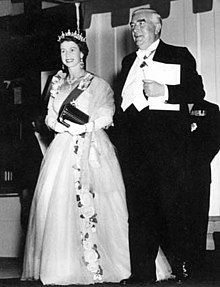
Australia has been governed as a FederatedConstitutional Monarchysince 1901. There have been two female heads of state in the history of theMonarchy of Australia.Queen Victoria,who reigned from 1837 to 1901, and was the reigning monarch when theConstitution of Australiacame into force, on 1 January 1901, after she gave it Royal Assent.[6][7]Queen Elizabeth IIreigned from 1952 to 2022, and from 1973 she was styled "Queen of Australia", to emphasise the separate constitutional status of the Australian Monarchy from the United Kingdom institution.[8]Queen Elizabeth celebrated her 70th jubilee in 2022 – the longest serving monarch in Australian history.
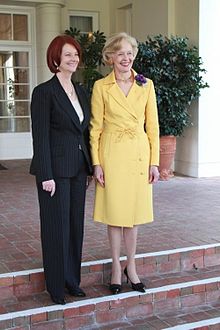
The Monarch is represented in Australia by Governors at a state level, and by the Governor-General at a Federal government level. There have been fifteenfemale state governors,since 1991 when DameRoma Mitchellbecame the 31stGovernor of South Australia.DameQuentin Brycebecame the first female Governor–General in 2008 and served until 2014.[9]
Women's suffrage[edit]
This section includes alist of references,related reading,orexternal links,but its sources remain unclear because it lacksinline citations.(September 2015) |

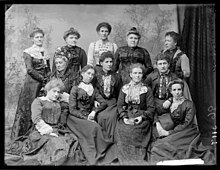
During the 19th century, Britain's Australasian colonies were at the vanguard of achieving both male and female suffrage. Australia's first council elections were held withmale suffragein 1840, while parliamentary elections were first conducted for theNew South Wales Legislative Councilin 1843, with voting rights (for males only) tied to property ownership or financial capacity. TheAustralian Colonies Government Act,passed in 1850, granted representative constitutions to New South Wales, Victoria, South Australia, and Tasmania and the colonies enthusiastically set about writing constitutions which produced democratically progressive parliaments – through the constitutions generally maintained the role of the colonial upper houses as representative of social and economic "interests" and all establishedConstitutional Monarchieswith theBritish monarchas the symbolic head of state.[10]1855 also saw the granting of the right to vote to all male British subjects 21 years or over inSouth Australia.This right was extended to Victoria in 1857 and New South Wales the following year. The other colonies followed until, in 1896, Tasmania became the last colony to grant universalmale suffrage.
While the female descendants of theBounty mutineerswho lived onPitcairn Islandscould vote from 1838, and this right transferred with their resettlement toNorfolk Island(now anAustralian external territory) in 1856, women in mainland Australia and New Zealand were next in the world to achieve such historic gains.[11]Following the successful establishment of voter rights for males,women's suffragegroups began to organise in Australia from the 1880s. The first was the Victorian Women's Suffrage Society, was formed byHenrietta Dugdalein 1884. The organisations involved in the suffrage movement varied across the colonies. A national body, the Australian Women's Suffrage Society, was formed in 1889, whose aims were to educate women and men about a woman's right to vote and stand for parliament. Key figures in the Australian suffrage movement included South AustraliansMary LeeandCatherine Helen Spence,Western AustralianEdith Cowan,New South WelshMaybanke Anderson,Louisa Lawson,Dora MontefioreandRose Scott,TasmaniansAlicia O'Shea PetersenandJessie Rooke,QueenslanderEmma Miller,and VictoriansAnnette Bear-Crawford,Henrietta Dugdale,Vida Goldstein,Alice HenryandAnnie Lowe.[citation needed]
In 1861 land-owningSouth Australianwomen had a vote in local elections. In 1894, theConstitutional Amendment (Adult Suffrage) Act 1894in South Australia followed New Zealand in extending the franchise to women voters – but went further than New Zealand and allowed women to stand for the colonial Parliament. South Australian women voted for the first time at the1896 South Australian election.In 1897Catherine Helen Spencebecame the first woman political candidate when she ran for election to the National Australasian Convention as one of ten delegates, but came 22nd out of 33 candidates. In 1899Western Australianwomen achieved voting rights for colonial elections but not the right to stand for the colonial Parliament. Women from both South Australia and Western Australia voted at the1901 election.[citation needed]
On 12 June 1902 theCommonwealth Franchise Actcame into effect, granting most Australian women the right to vote and stand in Commonwealth elections. Franchise ofIndigenous Australiansat the federal level was not universal until 1962, and voting by Indigenous Australians was not compulsory until 1984. The first election at which women used both the right to vote and stand for election was the1903 election,held on 16 December.
Following the inclusion of non-indigenous women in the 1903 election, many Australian women and the Australian government, led by Prime MinisterAlfred Deakin,used their experience to promotewomen's suffrage in the United Kingdomand elsewhere. 'Trust the Women Mother, As I Have Done', banner painted byDora Meesonwas carried at the head of the Australian and New Zealand Women Voters' Committee contingent in the Women's Suffrage Coronation March in London on 17 June 1911.
New South Wales, Tasmania, Queensland and Victoria followed the lead of the other states in allowing women to vote, and later to stand for election. Victoria, the last state to grant women's suffrage, had briefly allowed women to vote when theElectoral Act1863 enfranchised all ratepayers listed on local municipal rolls. Women in Victoria voted in the 1864general election.The legislative mistake was quickly repaired in 1865, and it took 19 private members' bills from 1889 until Victorian women gained the vote in 1908, and were able to exercise the vote in 1911. Women in theNorthern Territoryand theAustralian Capital Territorywere, as federal subjects, eligible to vote at the federal level from their establishment. By the time the territories achieved self-government in 1978 and 1989 respectively, they did not need to enact specific legislation to enable the women's vote.
The right to vote in local government elections was granted later in most jurisdictions than it was at the state and federal levels. The right to vote in local elections was also not automatic, as property ownership qualifications limited the eligibility to vote and stand for local elections.
Significantly from 2010 to 2011 the city ofSydneywas operating totally under female governance: from the Lord Mayor and State Member for SydneyClover Moore,to State PremierKristina Keneally,to State GovernorMarie Bashir,to Federal Member for SydneyTanya Plibersek,to Prime Minister of AustraliaJulia Gillard,to Governor–General of AustraliaQuentin Bryce,and of course, to the Australian Head of State,Queen Elizabeth II.
The first women elected to Australian parliaments have generally been members of the non-Labor (i.e., conservative) parties. This was the case in every state except for Tasmania, where an independent,Margaret McIntyre,was the first woman elected to parliament. The Labor Party first began to regularly nominate female candidates to parliament in the 1950s, generally only to the upper houses at first.
Since 2015,12 Indigenous womenhave been elected to state, territory or commonwealth parliaments, with 5 of whom having been ministers in a government starting withMarion Scrymgourin 2007.
| Parliament | Right to vote (a) | Right to stand | ||
|---|---|---|---|---|
| Commonwealth | 1902 (b) | 1902 | ||
| State | ||||
| South Australia | 1894 | 1894 | ||
| Western Australia | 1899 | 1920 | ||
| New South Wales | 1902 | 1918 | ||
| Tasmania | 1903 | 1921 | ||
| Queensland | 1905 | 1915 | ||
| Victoria | 1908 | 1923 | ||
| (a) The dates for the right to vote at State level refer to equal rights for women and men, but not necessarily universal rights; (b) Women in SA and WA were able to vote in the1901 federal election. | ||||
Women in politics[edit]
| Parliament | Right to stand | First elected to lower house | First elected to upper house | |
|---|---|---|---|---|
| Commonwealth | 1902 | 1943,Enid Lyons(UAP) | 1943,Dorothy Tangney(ALP) | |
| State | ||||
| South Australia | 1894 | 1959,Joyce Steele(LCL) | 1959,Jessie Cooper(LCL) | |
| Western Australia | 1920 | 1921,Edith Cowan(Nationalist) | 1954,Ruby Hutchison(ALP) | |
| New South Wales | 1918 | 1925,Millicent Preston-Stanley(Nationalist) | 1952,Gertrude Melville(ALP) | |
| Tasmania | 1921 | 1955,Mabel Miller andAmelia Best(bothLiberal) |
1948,Margaret McIntyre(independent) | |
| Queensland | 1915 | 1929,Irene Longman(CPNP) | n.a. | |
| Victoria | 1923 | 1933,Millie Peacock(UAP) | 1979,Gracia Baylor(Liberal) andJoan Coxsedge(ALP) | |
| Two women,Catherine GreenandEllen Webster,were appointed to the NSW Legislative Council in 1931. | ||||
Commonwealth government[edit]
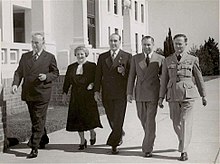
- Early Parliamentary Candidates
In 1902, Australia became the first nation in the world to introduce equal federal suffrage with the enactment of theCommonwealth Franchise Act 1902,which enabled women to both vote and stand in federal elections.[1]However, it would be four decades before female candidates were elected to serve in the FederalParliament of Australia.Nevertheless, four women stood for election at the1903 federal election.[12]They wereMary Moore-BentleyandNellie Martelfrom New South Wales, andVida Goldsteinfrom Victoria, all of whom stood for the Senate, andSelina Andersonwho contested the Sydney House of Representatives seat ofDalley.All failed to get major party endorsement and stood as independents, and all were unsuccessful. Goldstein stood for the Senate again in 1910, 1913, 1914 and 1917, all without success.Eva SeerycontestedLabor Partypreselection for the Senate in 1916 but was unsuccessful. She andHenrietta Grevillewere endorsed Labor candidates at the1917 federal election,though for safe conservative seats. Though unsuccessful they were the first women to stand for the Australian Parliament with major party endorsement.
- First Members, Senators & Ministers
At the1943 federal election,two women were elected to Parliament - DameEnid LyonsandDorothy Tangney.WithAustralian Labor Partyendorsement, Tangney was elected to theSenaterepresentingWestern Australia,an office she held until 1968. With the backing of theUnited Australia Party,Lyons was elected to theHouse of Representativesas the member for theDivision of Darwin,which was located inTasmania.In 1949 she became the first female member of cabinet, when Liberal Prime MinisterRobert Menziesappointed her Minister without Portfolio to enable her appointment to the honorary office ofVice-President of the Executive Council,an office she held until her retirement from parliament in 1951.
DameAnnabelle Rankinwon election for the Liberal Party representing Queensland at the 1946 Election and became Australia's second female Senator. She served asGovernment Whipfrom 1951 to 1966 in theMenzies government,and was appointedMinister for Housingin theHolt governmentin 1966, the first woman to head a government department.[13]In 1975, Liberal Senator DameMargaret Guilfoylebecame the first female cabinet minister with a portfolio, following her appointment asMinister for Educationin theFraser government.[14]Agnes Robertsonwas elected as the fourth female Senator in 1949, and was elected as the first Country Party (nowNational Party) Senator at the 1955 election, after losing endorsement for the Liberals and switching allegiance. She went on to be appointed as the first female member of the Joint Committee on Foreign Affairs in 1956.[15]
- Further milestones
In 1983 Labor MPRos Kellybecame the first woman to give birth while an MP.Florence Bjelke-Petersenbecame Deputy Leader of the National Party in the Senate in 1985 and remained in the role until 1990.[16]In 1986 there were two firsts,Joan Childbecame the first femaleSpeaker of the House of RepresentativesandJanine Hainesbecame the first woman to lead a parliamentary party when she became head of theAustralian Democrats.Margaret Reidbecame the first femalePresident of the Senatein 1996.Nova PerisandJacqui Lambiewere the first twoindigenous womento enter federal politics in 2014.
Kathy Sullivanwas the first woman to haveserved in both the Senate and the House of Representatives.
- First Woman Prime Minister

On 24 June 2010,Julia Gillardbecame the first woman to lead one of the major political parties at the federal level as Leader of the Australian Labor Party, as well as the first female Prime Minister of Australia. However, as it became clear that her government was headed for a heavy defeat, she was deposed by her own party in June 2013 in favour of former Prime MinisterKevin Rudd,whom she had replaced in a similar coup.
- Ongoing developments
Julie Bishophad become the first female Deputy Leader of the Liberal Party in 2007, and with the election of theAbbott governmentin 2013, became Australia's first femaleMinister for Foreign Affairs.[17]The National Party also had its first female Deputy Leader over the period inFiona Nash,who held the position from 2008 to 2017.[18]
In December 2014, Liberal MPBronwyn Bishopeclipsed Kathy Sullivan's earlier record of 27 years to become the longest-serving female Member of the Australian Federal Parliament.[19]She was nominated Speaker of the House of Representatives by Prime MinisterTony Abbott,and served in the role from 2013 to 2015.[20]
Following the2016 Australian federal electionthere were 73 women members of both Houses of the Australian Parliament, representing 32% of all seats in the Senate and House of Representatives.[21]
At the2019 federal election,of the 68 members of the Labor Party in the House of Representatives 28 were women (41.2%). In the Liberal Party, of the 61 members, 13 were women (21.3%). For the Nationals, it had 2 women among 16 members (12.5%). Of the Independents there were 3 women among 6 members (50.0%). Overall, there were 45 women among 151 members (29.8%).[citation needed]
The Liberal–National government'sSecond Morrison Ministryreached an historic high of seven women in Cabinet, including Foreign MinisterMarise Payne,who previously served as Australia's first female Defence Minister, and became the longest-serving female senator in Australian history, as well as the longest current serving female member of federal parliament in 2022.[22][23]Following the2022 Australian federal election,theAlbanese Governmentsurpassed the record set by theMorrison governmentwith the appointment of ten women parliamentarians to cabinet.[24]This election also saw a number of female "teal independents"elected to parliament.[25]
Commonwealth Public Service[edit]
TheCommonwealth Public Service Act 1902provided that every female officer was "deemed to have retired from the Commonwealth service upon her marriage",[26][27]with the exception of women working in agencies transferred from a state to the Commonwealth. The very great majority of women were effectively blocked from non-secretarial positions in the Commonwealth Public Service. In 1949 women were allowed into the clerical division of the service but they remained restricted by themarriage bar.In November 1966, Australia became the last democratic country to lift the legislated marriage bar which had prevented married women from holding permanent positions in the public service.[26]
State and territory governments[edit]

The first woman elected to a state parliament wasEdith Cowan,when she was elected to theWestern Australian Legislative Assemblyin 1921.Millicent Preston-Stanleywas elected to theNew South Wales Legislative Assemblyin 1925,Irene Longmanwas elected to theLegislative Assembly of Queenslandin 1929 andMillie Peacockwas elected to theVictorian Legislative Assemblyin 1933. Ironically, South Australia as the first state to allow women to sit in state parliament, was also the last to have a female sitting member whenJoyce SteeleandJessie Cooperwere elected on the same day in 1959. Both theAustralian Capital Territory Legislative AssemblyandNorthern Territory Legislative Assemblyhad women in their inaugural Parliaments. Women were not elected to the upper house of state parliaments until after World War II; no woman was elected to the Victorian upper house until 1979, whenGracia Baylor(Liberal) andJoan Coxsedge(ALP) were elected.
In 1989Rosemary Follettbecame the first female head of government in Australia, asChief Minister of the Australian Capital Territory.Carmen Lawrencewas the first female premier of an Australian state when she took the office ofPremier of Western Australiain February 1990. She was followed by the appointment ofJoan KirnerasPremier of Victoria,in which position she served from 1990 to1992,when her party was swept from office byJeff Kennett's conservatives.Clare MartinwasChief Minister of the Northern Territoryfrom2001to 2007.Anna BlighbecamePremier of Queenslandin 2007 whenPeter Beattieretired. In2009,she became the first woman in Australia to be elected Premier, though she subsequently suffered a landslide loss toCampbell Newman'sLNPin2012.On 4 December 2009,Kristina KeneallyreplacedNathan Reesto become the first femalePremier of New South Wales.AsCarmel Tebbuttretained the role ofDeputy Premier,Keneally also led the first executive in Australia to be led by two women.[28]However, Keneally would also go on to suffer a crushing defeat at the hands ofBarry O'Farrellin2011.In 2011Lara Giddingsbecame the first femalePremier of Tasmania,serving until2014when she likewise suffered a crushing loss to conservative leaderWill Hodgman.This again leaves South Australia as the only state or territory not to have had a female head of government. Marion Scrymgouris to date the highest rankedIndigenous womanin a government in Australia when she wasDeputy Chief Minister of the Northern Territoryfrom 2007 until 2009.
Prior to Labor's massive loss in 2012 theLegislative Assembly of Queenslandhad the highest female parliamentary representation in Australia and the third highest in the world, with 30 out of 89 Members having been women.[29][30]However, thenext state electionresulted inAnnastacia Palaszczukbecoming the first woman to becomePremierfromopposition.The subsequentgovernmentwould become the second in Australia to be headed by two women and the first ministry in Australia to have a female majority.[31]
On 3 March 2018, Australia passed another milestone when, at the2018 Tasmanian election,Tasmanianselected a majority of women to theTasmanian House of Assembly,with 13 women and 12 men.[32]Seven of the ten Labor members are women, four of the 13 Liberals and both of the Greens.
As at 27 November 2018, following the2018 Victorian state election,50% of Ministers in thesecond Victorian Andrews Governmentwere female,[33]and following cabinet changes on 23 March 2020, a majority of the cabinet was female.
DameRoma Mitchellwas made the first female Justice of the Supreme Court of South Australia in 1965, at the recommendation ofDon Dunstan,South Australia's 38th Attorney-General.[34]She was still the only female judge in South Australia when she retired 18 years later in 1983 although JusticesElizabeth EvattandMary Gaudronhad been appointed to federal courts by theWhitlamGovernment. It was not until 1993 that the second woman was appointed to the court, Mitchell's former student, Margaret Nyland.
Local government[edit]
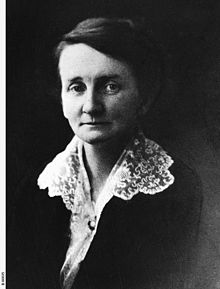
The first woman elected to a local government authority in Australia wasGrace Benny,who was elected to the Brighton Council in South Australia in 1919. In 1920Mary Rogerswas elected to Richmond City Council, Victoria andElizabeth Claphamwas elected to Western Australia'sCottesloe Municipal Council.Queensland's first female councillor was DrEllen Kent-Hughes,elected to Kingaroy Shire Council in 1923.[35]New South Wales' first female alderman wasLilian Fowler,elected in 1928 to Newtown Municipal Council; she was later to become Australia's first woman mayor.Dorothy Edwards,Tasmania's first female alderman, was elected to Launceston City Council in 1950 and became the first female mayor of an Australian city in 1955.[36] Australia's first female lord mayor,Joy Cummings,was elected to Newcastle City Council in 1974.
In 1951 the Australian Local Government Women's Association (ALGWA) was formed. The ALGWA is an association of local government women helping other women to join them.
In 1975 Western Australia and the Northern Territory elected their first women mayors, CouncillorEvelyn H. Parkerof theCity of Subiaco[37][38]and DrElla Stackof theCity of Darwinrespectively.
In the 1980s women began to hold the position of Lord Mayor in the capital cities for the first time, including:
- Adelaide –Wendy Chapman(1983–1985)
- Brisbane –Sallyanne Atkinson(1985–1991)
- Hobart –Doone Kennedy(1986–1996),Sue Hickey(2014–2018) andAnna Reynolds(2018–present)
- Melbourne –Lecki Ord(1987–1988),Winsome McCaughey(1988–1989) andSally Capp(2018–present)
- Sydney –Lucy Turnbull(2003–2004) andClover Moore(2004–present)
- Perth –Lisa Scaffidi(2007–2018)
| Right to vote (a) | Right to stand | First elected | |
|---|---|---|---|
| State | |||
| South Australia | 1861 | 1914 | 1919,Grace Benny |
| Western Australia | 1876 | 1919 | 1920,Elizabeth Clapham |
| Victoria | 1903 | 1914 | 1920,Mary Rogers |
| Queensland | 1879 | 1920 | 1923,Ellen Kent-Hughes |
| City of Brisbane | 1924 | 1924 | 1949,Petronel White |
| Tasmania | |||
| Rural | 1893 | 1911 | 1957,Florence Vivien Pendrigh |
| Hobart City Council | 1893 | 1902 | 1952,Mabel Miller |
| Launceston City Council | 1894 | 1945 | 1950,Dorothy Edwards |
| New South Wales | |||
| Sydney City Council | 1900 | 1918 | 1965,Joan Mercia Pilone |
| Municipalities and Shires | 1906 | 1918 | 1928,Lilian Fowler |
| (a)The right to vote in local elections was not necessarily universal since there were property ownership restrictions on the right to vote in many local jurisdictions.[39] | |||
Other milestones[edit]
In 2010, Australia had female leaders occupying every major political office, withClover Mooreas Lord Mayor,Kristina Keneallyas Premier of New South Wales,Marie Bashiras Governor of New South Wales,Julia Gillardas prime minister,Quentin BryceasGovernor-General of Australia,andElizabeth IIasQueen of Australia.
As of April 2023: TheGovernor of New South WalesMargaret Beazley,Governor of QueenslandJeannette Young,Governor of South AustraliaFrances Adamson,Governor of TasmaniaBarbara BakerandGovernor of VictoriaLinda Dessauare women. Meaning that out of 6 Governors, 5 are women.
See also[edit]
- Women in Australia
- Women in the Australian House of Representatives
- Women in the Australian Senate
- 2021 Australian Parliament rape allegations
References[edit]
- ^abFirst women in parliament;Australian National Museum; online 30 June 2022
- ^Trends in the gender composition of the Australian parliament;aph.gov.au
- ^"AEC.gov.au".AEC.gov.au. 25 October 2007.Retrieved27 June2010.
- ^Constitution (Female Suffrage) Act 1895 (SA)Archived3 December 2010 at theWayback Machine.Documenting a Democracy. Retrieved 21 March 2012.
- ^Museum of Australian Democracy, Old Parliament House."Constitution Acts Amendment Act 1899 (WA)".Documenting a Democracy.Retrieved26 August2021.
- ^"Commonwealth Of Australia Constitution Bill – Hansard – UK Parliament".UK Parliament.Retrieved8 May2022.
- ^"Commonwealth of Australia Constitution Act 1900".legislation.gov.uk.British Government. 9 July 1900.Retrieved9 March2022.
- ^"Royal Style and Titles Act 1973 (Cth)";Museum of Australian Democracy.
- ^Australia swears in first female governor general;theguardian.com.au
- ^"The Right to Vote in Australia – Australian Electoral Commission".Aec.gov.au. 26 November 2007.Archivedfrom the original on 20 April 2013.Retrieved19 April2011.
- ^EC (13 April 2005)."Votes for Women | Elections New Zealand".Elections.org.nz. Archived fromthe originalon 19 August 2012.Retrieved19 April2011.
- ^"Electoral Milestones for Women – Australian Electoral Commission".Aec.gov.au. 17 December 2008.Retrieved19 April2011.
- ^RANKIN, DAME ANNABELLE JANE MARY (1908–1986);Biographical Dictionary of the Australian Parliament
- ^GUILFOYLE, DAME MARGARET GEORGINA CONSTANCE (1926–2020);Biographical Dictionary of the Australian Parliament
- ^ROBERTSON, AGNES ROBERTSON (1882–1968);Biographical Dictionary of the Australian Parliament
- ^Monument Australia: Lady Flo Bjelke-Petersen;monumentaustralia.org.au
- ^The Hon Julie Bishop;Australian National University
- ^Parliament of Australia: Fiona Nash
- ^Hard work brings Bishop a recordThe Australian[dead link]
- ^Bishop, Bronwyn Kathleen (1942–); Australian Dictionary of Biography
- ^"The gender composition of the 45th parliament".
- ^Scott Morrison says his Cabinet maintains a record representation of women. Is he correct?;abc.net.au; 5 June 2019
- ^Longest-serving female senator recognised;7news.com.au; 18 February 2022
- ^Anthony Albanese boasts of appointing ‘largest number of women ever in an Australian cabinet’;theguardian.com; 31 May 2022
- ^Wright, Clare (22 May 2022)."History tells us women can turn elections: the Liberals should have listened".the Guardian.Retrieved23 May2022.
- ^abSawer, Marian (2004)."Women and Government in Australia".Australian Bureau of Statistics. Archived fromthe originalon 12 May 2013.
- ^Australian Public Service Commission,The Appendixes: Salary, severance benefits and miscellaneous leave,Australian Public Service Commission, archived fromthe originalon 15 May 2013
- ^Clennell, Andrew (3 December 2009)."Keneally first female NSW Premier".The Sydney Morning Herald.Retrieved3 December2009.
- ^Sanderson, Nicole (December 2006)."in the hot seat – Lindy Nelson-Carr"(PDF).profile.CityLife Townsville.Retrieved29 July2007.[dead link]
- ^"Women in the Queensland Parliament".Archived fromthe originalon 15 May 2009.Retrieved30 July2007.
- ^"Historic day for women in Queensland".Sunshince Coast Daily.16 February 2015.Retrieved27 April2015.
- ^ABC News, 16 March 2018,Tasmania leading the way on female representation in Parliament
- ^Daniel Andrews gets gender parity in fresh cabinet
- ^Margarey, Susan (1 April 2008)."Dame Roma Mitchell's Unmentionables: Sex, Politics and Religion".History Australia:12.1–12.20 – via Research Gate.
- ^"WOMEN IN POLITICS".Telegraph (Brisbane, Qld.: 1872 – 1947).15 September 1923. p. 12.Retrieved15 October2018.
- ^"Dorothy Edwards".Stirrers With Style: Presidents of the National Council of Women of Australia and its Predecessors.The Australian Women's Register.Retrieved1 June2022.
- ^"[Interview with Evelyn Helena Parker, Mayor of Subiaco] [sound recording] / [interviewed by Gail O'Hanlon]".State Library of Western Australia.1992.Retrieved24 February2022.
- ^Towns, Deborah."Parker, Evelyn Helena (1907 - 1993)".The Encyclopedia of Women & Leadership in Twentieth Century Australia.Retrieved24 February2022.
- ^Modified from Sawer, 2001
- Commonwealth Office of the Status of Women. 2002.Our Centenary of Women's Suffrage
- Haines, J. 1993.Suffrage to Sufferance.Allen and Unwin.ISBN1-86373-365-5
- Parliament of New South Wales.Women in Parliament
- Sawer, M. 2001.Women and government in Australia,InYear Book of Australia,2001, Australia Bureau of Statistics, Catalogue #1301.01
- Sawer, M. and Simms, M. 1993.A woman's place.Allen and Unwin.ISBN1-86373-169-5
- Scott, M. 2003.How Australia led the way: Dora Meeson Coates and British Suffrage.Commonwealth Office of the Status of WomenISBN1-877042-40-4
- Walsh, K. Ed. 2004.One Hundred Years of Women's Suffrage in Australia,Papers on Parliament No. 41. Department of the Senate
